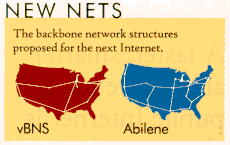|
Update: Internet 2
|
 |
August 24, 1998: 5:18 p.m. ET
A faster, smarter alternative to the public Internet is almost ready
|
SAN FRANCISCO (The Red Herring) - Will Dungeons & Dragons and teleneurosurgery ever be able to coexist on a public network?
Steve Wolff, the executive director of advanced Internet initiatives at Cisco Systems, was pondering this question as early as 1990. He concluded that it wouldn't be a possibility until networking technology became sophisticated enough to provide ample bandwidth and prioritize traffic so that, say, a time-critical medical consultation could preempt an interactive game.
When the National Science Foundation (NSF) commercialized the first public Internet--previously called NSFNet--in 1991, the network lacked the bandwidth and reliability necessary for most businesses' applications. But a grassroots initiative, begun in 1996 and dubbed Internet 2, plans to test traffic-prioritization features on a new IP backbone called the Abilene Project. (For a look at Internet 2's origins, see "Internet 2: Is the sequel here already?.")
"One of the things we discovered with NSFNet is that things that look good in a small environment don't always work on a larger scale," says Doug Van Houweling, president of the University Corporation for Advanced Internet Development (UCAID), which directs Internet 2. Comprising 130 universities, UCAID aims to simulate the real-world demands of a public network more effectively than the NSF did before it released the first Internet.
The project is not the first effort to improve the public Internet. In fact, in 1993 the NSF and MCI began developing a new IP backbone called the Very High-Performance Backbone Network Service (vBNS), which can be used by a limited number of universities approved by the NSF. Universities that are unable to use the vBNS are counting on Internet 2 to provide an alternative high-performance networking environment. Current vBNS users will also have access to the Abilene backbone when it's completed and, once the new version of the Internet is commercialized, will be able to employ both backbones interchangeably. (For a comparison of the two, see diagram, below.)

Abilene's infrastructure will be donated by Qwest Communications International; Cisco and Northern Telecom also will donate equipment. The new network will offer an immense increase in bandwidth capacity. The present Internet supports an average throughput per user of only 40 kbps, but Van Houweling claims that "Internet 2 will begin at 2.4 gbps near the end of 1998, and we have a path to get us up to 9.6 gbps."
In addition to providing fatter pipes, Internet 2 has taken the first steps toward replacing the original Internet's "best efforts" service model. On the vBNS backbone, MCI has already begun using virtual-bandwidth reservations, in which users signal how much bandwidth they're going to need at a scheduled time. Internet 2 researchers hope to go one step further and differentiate various classes of service inside the router through a process called buffer management. Types of data will be assigned class labels according to their tolerance for delays, so that information can be processed in order of urgency.
Although the Abilene backbone still has a ways to go, UCAID is already evaluating concepts for Internet 2 application development and selecting partners to participate in the next phase of the network's advancement. The project is not intended to produce short-term results, says Van Houweling, but to help the universities and corporations that partner with Internet 2 emerge as technological leaders in the next two to five years.
However long the wait, droves of software developers are sure to welcome the opportunity to write sophisticated applications for a much more powerful networking environment.
Table of contents
|
|
|
|
|
 |

|

